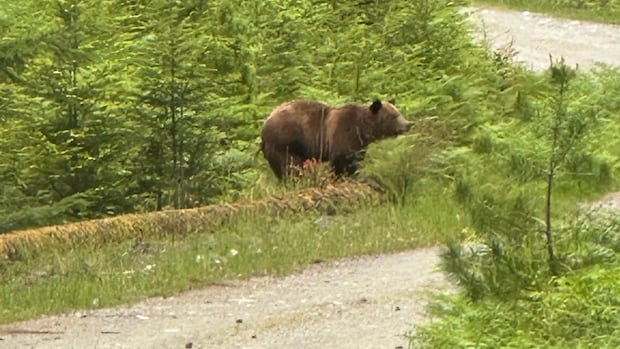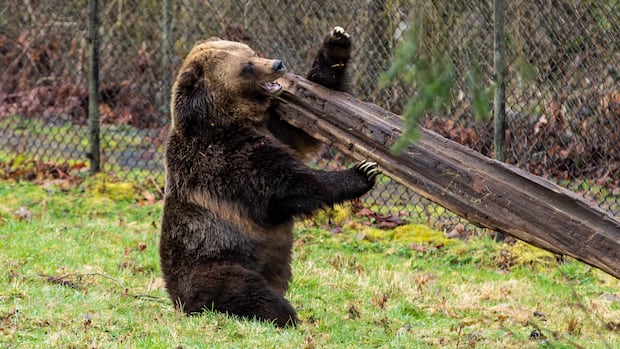As people continue to mourn the loss of a wayward grizzly on an island off the B.C. coast, many are left wondering why the bear wasn’t relocated to avoid what some say was its certain fate.
In fact, despite the province’s repeated claims that the bear had already been moved twice and thus wasn’t a good candidate for relocation, a secret plan to transport him to a remote location was in place.
“We had a very well thought-out plan and everybody on standby,” said Erik Blaney, the shíshálh Nation’s acting manager of lands and resources.
“He would have been living his best life up there.”
That plan was laid to rest when conservation officers investigated a report that the grizzly had been shot and wounded, and then discovered its carcass earlier this week.
Some local residents were shocked to find out about the relocation plan, given conservation officers’ previous claims it would be impossible. Others think the bear could still be alive if they had been given information about the plan.
But Blaney says social media and the misinformation that often comes with it made that impossible.

Blaney, a legislator with the Tla’amin Nation, says the plan that he had hatched nearly three weeks ago was eventually approved by the province, with some minor changes.
Details were kept under wraps and only shared with a handful of people. Some Texada Island residents — many of whom had asked for weeks for the bear to be relocated — are wondering why they weren’t made aware of it.
“It’s unfortunate that the community wasn’t [informed],” said Texada Island resident Daniel Cammiade.
“[If we had] I think that it’s quite possible that the bear would still be alive.”
Calls for relocation
The five-year-old male grizzly was first spotted on Texada Island on May 25. Texada residents say the island is a predator-free community, and many were worried about the bear’s presence.
While some called for peaceful coexistence with the bear, many others wanted it relocated for its safety and their own.
What should happen to the grizzly bear on Texada Island? It’s been causing problems in the community of about 1,000 people and they are divided on whether it should be killed, removed, or left alone. Three coastal First Nations have an idea.
“It seems like things were left in the community’s hands — a community that was not used to dealing with bears,” Cammiade said.
The B.C. Conservation Officer Service repeatedly told CBC News the bear wasn’t a good candidate for relocation because it had already been relocated twice, but also said there was no “kill order” for the animal.
Solution hatched
By the end of June, Blaney’s plan had been hatched.
Working with the shíshálh, Homalco and Tla’amin nations, he wanted to trap the bear and move it to Bute Inlet, on Homalco territory, where it could live with other coastal grizzlies and be far enough away that it couldn’t swim back.
“I’ve worked up there for many years now and it’s a pretty hard trek to get into town,” Blaney told CBC News.
“And there’s plentiful salmon runs where we were going to drop them off and a really good pink salmon run expected this year.”
All Points WestGrizzly spotted on Texada Island
The B.C. Conservation Officer service says it’s believe a grizzly bear swam from Powell River to Texada Island. Texada resident Mark Robert shares the story of spotting it with guest host Rohit Joseph.
But the province didn’t sign off on that plan.
Blaney said the province told him that what they were asking was outside current policy — and that to capture and move the bear without a permit could lead to charges under the Wildlife Act.
Change of plans
Without informing the public, the province changed its mind.
Speaking with CBC’s On the Island guest host Kathryn Marlow Wednesday morning, Minister of Water, Land and Resource Stewardship Randene Neill confirmed that the plan was approved almost two weeks ago.
“We had a meeting with the local nation there, the Homalco Nation, in partnership with the shíshálh Nation as well, who came up with a really robust, clear plan about how they wanted to translocate it in partnership with the Grizzly Bear Foundation,” said Neill, who is also the MLA for Powell River-Sunshine Coast.
“After talking to all of our specialists and our team, we agreed to try this translocation.”

Blaney says the nations worked with provincial officials to remind them that the shíshálh and Tla’amin nations are self-governing, and the province had an obligation to work with them to manage their wildlife resources.
“They can’t just do the old paternalistic land and resource management around us or without us. Those decisions actually need to be made by the self-governing nations,” he said.
Kept a secret
The exact plan was kept secret, Blaney says, in order not to compromise any of the details.
Blaney didn’t want people hindering relocation efforts by posting about the trap’s location on social media.
Texada Island residents had created a Facebook group to post information about the bear, including its location.
He says getting the right trap to Texada Island had already been delayed because of a claim on social media that the bear had been shot last week.
That led officers to reroute the trap to Pemberton to relocate a bear in that area, Blaney says, and it took days to get the trap back to Texada.
Blaney says the trap was ready to go Tuesday morning, the day conservation officers announced the bear had been shot. Later that morning, the grizzly was found dead.
“We had six staff ready for deployment and the plan in place, helicopter on standby,” he said.
It was too late.
The bear’s death is still under investigation.

